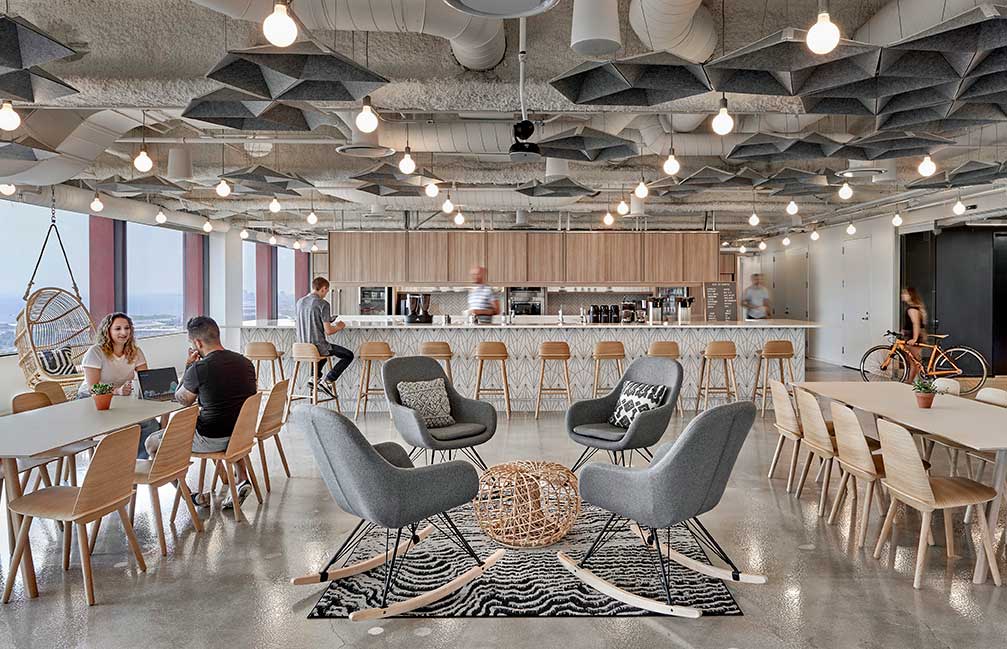Introduction:
Promoting collaboration among co-workers is essential for any organization looking to foster team unity and encourage positive interactions. Creating a workspace that encourages creativity and teamwork requires thoughtful planning in order to ensure that everyone has access to the amenities they need throughout the day while also providing an inviting atmosphere where colleagues can come together to exchange ideas and work on projects as a team. Open office layouts offer employers an opportunity to create such an environment by utilizing features like versatile quality furniture, ample natural light, art or color splashes, and amenities such as water coolers and coffee machines. With thoughtful planning, it’s possible to design an office space that encourages productivity and collaboration among team members. However, it’s important to consider both advantages and disadvantages of open offices, and how to plan the layout for the best possible outcome.
The Benefits of Open Office Spaces:
Open office spaces have become increasingly popular in recent years, and for good reason. One of the most significant benefits of open office spaces is increased collaboration and communication among employees. Without walls or cubicles separating individuals, team members can easily interact with one another, share ideas, and solve problems in real-time. This can lead to a more dynamic and productive work environment, where creativity and innovation thrive. Open office spaces also tend to be more cost-effective than traditional offices, as they require less space and fewer materials to construct. In addition, they can help foster a sense of community and teamwork, as employees work together in a shared space. Finally, open office spaces can offer greater flexibility and adaptability, allowing organizations to reconfigure their workspace as needed to accommodate changes in their workforce or business needs. With careful planning, it’s possible to design an office space that optimizes productivity while still providing a pleasant work environment for all members of the team.
How to Create an Effective Open Office Layout:
Designing an effective open office layout requires careful consideration of several factors. First, it’s essential to consider the specific needs of your employees and the tasks they perform. An effective layout should support their workflow and enable them to work comfortably and efficiently. This can include providing ample desk space, ergonomic chairs, and appropriate lighting.
Another critical aspect of an effective open office layout is creating designated areas for collaboration and socialization. These areas can include meeting rooms, breakout spaces, and communal areas such as kitchens or lounges. By providing spaces for employees to interact and connect, you can foster a sense of community and collaboration that can enhance productivity and job satisfaction.
Noise management is another critical consideration when designing an open office layout. Providing sound-absorbing materials, such as acoustic ceiling tiles and wall panels, can help reduce distractions and improve concentration. Additionally, providing private spaces for employees to take calls or work on sensitive projects can help maintain a sense of privacy and minimize disruptions.
Finally, it’s crucial to consider the overall aesthetic of the workspace. Incorporating natural light, plants, and artwork can create a more inviting and enjoyable work environment. By creating a space that employees enjoy spending time in, you can help foster a positive work culture and enhance employee engagement.
How to Promote Collaboration with Co-workers in an Open Office Space:
Promoting collaboration with co-workers in an open office space requires intentional effort and a few key strategies. Firstly, establish clear communication channels that allow team members to share ideas and provide feedback easily. This could include regular team meetings, chat or messaging platforms, or in-person brainstorming sessions. Encourage employees to participate and contribute their ideas during these interactions. Secondly, provide common areas such as meeting rooms, break rooms, or collaborative spaces that promote social interaction and informal conversations. This can foster a sense of community among team members and encourage cross-functional collaboration. Thirdly, create a culture of openness and trust by celebrating diversity and encouraging respectful communication. Avoid micromanaging or creating a hierarchical structure that could hinder collaboration. Lastly, invest in tools and technology that support collaboration, such as project management software or cloud-based platforms that allow for real-time collaboration and document sharing. By implementing these strategies, open office spaces can promote collaboration and create a productive and dynamic work environment.
The Pros and Cons of Open Office Spaces:
Open office spaces have both advantages and disadvantages that should be considered when creating a workspace. On the plus side, open offices encourage collaboration between co-workers by providing an inviting atmosphere that encourages creativity and teamwork. The lack of walls and barriers also helps to create a sense of inclusion among all members of the team, promoting a sense of community. Additionally, open office spaces often provide amenities like water coolers and coffee machines which are essential for keeping employees refreshed throughout the day.
On the other hand, there are some drawbacks to open office spaces as well. Without physical barriers to separate private conversations, it can be difficult for employees to focus on their work without distractions from their colleagues. Similarly, open office layouts often require higher air conditioning costs due to the lack of insulation from outside elements. Additionally, research has indicated that open office layouts can lead to higher levels of stress among employees due to their inability to control their environment or take privacy breaks where needed.
How to Overcome the Challenges of an Open Office Workspace:
Working in an open office space can be both a blessing and a curse. On the one hand, it encourages collaboration between co-workers by providing an inviting atmosphere that encourages creativity and teamwork. On the other hand, it can also lead to higher levels of stress due to lack of privacy or control over their environment. Fortunately, there are steps employers can take to help employees overcome the challenges that come with working in an open office layout.
The Importance of Collaborations Among Co-workers for Work Culture:
Collaboration among co-workers is critical for creating a productive and positive work culture. It encourages creativity, team unity, and facilitates the exchange of ideas between colleagues. Working together as a team also helps to foster a sense of community within an organization, allowing employees to feel connected and supported by their peers. Promoting collaboration in the workplace can help to improve morale, increase efficiency, and create an environment where everyone feels valued and respected.
When employees collaborate effectively, they are more likely to feel engaged and motivated, leading to increased productivity and job satisfaction. In today’s fast-paced and complex work environments, no single individual can have all the necessary skills and expertise to complete every task required to achieve organizational goals. Therefore, working collaboratively with colleagues allows team members to leverage each other’s strengths and learn from one another, creating a sense of camaraderie and shared responsibility. By working together to solve problems and generate ideas, employees can develop a stronger sense of connection to their work and their colleagues. Ultimately, collaboration is an essential element of a productive and positive work culture, one that values teamwork and fosters a sense of community.
Conclusion:
In conclusion, open office spaces have become increasingly popular in recent years as they have been found to promote collaboration among coworkers. By eliminating walls and barriers, open office spaces encourage communication and interaction among colleagues, leading to the exchange of ideas and increased productivity. Moreover, they provide an atmosphere of shared space and responsibility, making employees feel more connected to their colleagues and the organization as a whole. However, it is important to note that open office spaces may not be suitable for all individuals and may require careful planning and consideration of individual needs and preferences. Nonetheless, when properly implemented, open office spaces can create a positive and collaborative work environment that benefits both employees and the organization.

